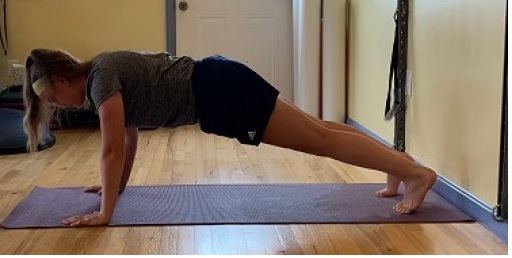Holding a plank

Holding a plank takes more then just a strong and stable core.
Recently, I had a client who could not hold a plank for more then 20-25 seconds. I knew she had a strong and stable core and she could utilize her low level core muscles properly. The alignment of her TPC was perfect and she could maintain her 3-dimensional breathing.
Checkmark next to all the A,B,C’s (alignment, breathing control)
So, what would the problem be if not her core or A,B,C’s?
Let me walk you through her case study:
Credit my daughter for all the pictures.
First, I asked her a couple questions to rule out some things. I asked her about her breathing, did she feel like it was labored, or did she feel like she couldn't get her breathes in and maintain 3-dimensional breathing. Breathing was not a problem.
I asked her how she felt from the ribcage down when doing the plank? She told me she felt strong in both her core and her legs.
I asked her if she felt like she was gripping through her neck and shoulders and how she felt from the rib cage up? She thought about that for a moment. She couldn't feel gripping, but she said her arms felt shaky and weak.
We did her self-check, standing trunk rotation, followed by a plank. She held it for about 25s. After the plank we did her self-check again. Sure enough her standing rotation was not as good.
We now had clear evidence that her nervous system did not like her doing the plank.
I had her do a prone extension on the wall (see pictures and description below) to see if she was firing her serratus muscle. The right side fired right up, but she said she could not really feel the left side fire at all.
Prone Extension Exercise

First, make sure the rib cage is aligned over top the pelvis and the head and neck are long.
Activate the hand tripod by placing hands on the wall just above shoulder height. As you maintain alignment of the head, neck and thorax gently feel as if you are pulling your hands apart on the wall. This motion will allow you to activate the serratus muscle. Or feel the lack of activation on one side or the other.
Since she could not feel the left side fire up at all I had her use the serratus release exercise. See the video below. This exercise not only releases the serratus if it is tight. It can also help activate an underactive serratus muscle.
After she performed the release on the left side I had her redo the prone extension exercise on the wall. She felt both sides fire up equally. This time when she performed her plank she held it for the designated time and she said her upper body felt strong and stable.
I have a lot of clients come in and tell me they have a weak core. They assume weak core because they can't hold a plank or maybe their doctor has told that’s why their back hurts all the time.
Next time you are struggling with an exercise (core or otherwise) don't just assume you are weak, maybe you have muscles that aren't firing properly.
Stay Motivated,

